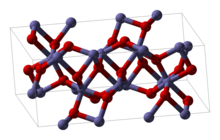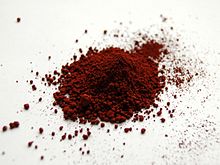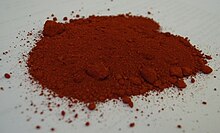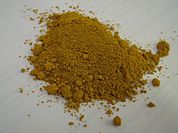Iron(III) oxide
 | |

| |

| |
| Names | |
|---|---|
| IUPAC name
Iron(III) oxide
| |
| Other names | |
| Identifiers | |
3D model (JSmol)
|
|
| ChEBI | |
| ChemSpider | |
| ECHA InfoCard | 100.013.790 |
| EC Number |
|
| E number | E172(ii) (colours) |
| 11092 | |
| KEGG | |
PubChem CID
|
|
| RTECS number |
|
| UNII | |
CompTox Dashboard (EPA)
|
|
| |
| Properties | |
| Fe2O3 | |
| Molar mass | 159.687 g·mol−1 |
| Appearance | Red solid |
| Odor | Odorless |
| Density | 5.25 g/cm3[1] |
| Melting point | 1,539 °C (2,802 °F; 1,812 K)[1] decomposes 105 °C (221 °F; 378 K) 150 °C (302 °F; 423 K) 50 °C (122 °F; 323 K) 92 °C (198 °F; 365 K) |
| Insoluble | |
| Solubility | Soluble in diluted acids,[1] barely soluble in sugar solution[2] Trihydrate slightly soluble in aq. tartaric acid, citric acid, acetic acid[2] |
| +3586.0x10−6 cm3/mol | |
Refractive index (nD)
|
n1 = 2.91, n2 = 3.19 ( |
| Structure | |
| Rhombohedral, hR30 ( Cubic bixbyite, cI80 ( Cubic spinel ( Orthorhombic ( | |
| R3c, No. 161 ( Ia3, No. 206 ( Pna21, No. 33 ( | |
| 3m ( 2/m 3 ( mm2 ( | |
| Octahedral (Fe3+, | |
| Thermochemistry[6] | |
Heat capacity (C)
|
103.9 J/mol·K[6] |
Std molar
entropy (S⦵298) |
87.4 J/mol·K[6] |
Std enthalpy of
formation ( |
−824.2 kJ/mol[6] |
Gibbs free energy (
|
−742.2 kJ/mol[6] |
| Hazards | |
| GHS labelling: | |
 [7] [7]
| |
| Warning | |
| H315, H319, H335[7] | |
| P261, P305+P351+P338[7] | |
| NFPA 704 (fire diamond) | |
Threshold limit value (TLV)
|
5 mg/m3[1] (TWA) |
| Lethal dose or concentration (LD, LC): | |
LD50 (median dose)
|
10 g/kg (rats, oral)[9] |
| NIOSH (US health exposure limits): | |
PEL (Permissible)
|
TWA 10 mg/m3[8] |
REL (Recommended)
|
TWA 5 mg/m3[8] |
IDLH (Immediate danger)
|
2500 mg/m3[8] |
| Related compounds | |
Other anions
|
Iron(III) fluoride |
Other cations
|
Manganese(III) oxide Cobalt(III) oxide |
Related iron oxides
|
Iron(II) oxide Iron(II,III) oxide |
Except where otherwise noted, data are given for materials in their standard state (at 25 °C [77 °F], 100 kPa).
| |

Iron(III) oxide or ferric oxide is the inorganic compound with the formula Fe2O3. It occurs in nature as the mineral hematite, which serves as the primary source of iron for the steel industry. It is also known as red iron oxide, especially when used in pigments.
It is one of the three main oxides of iron, the other two being iron(II) oxide (FeO), which is rare; and iron(II,III) oxide (Fe3O4), which also occurs naturally as the mineral magnetite.
Iron(III) oxide is often called rust, since rust shares several properties and has a similar composition; however, in chemistry, rust is considered an ill-defined material, described as hydrous ferric oxide.[10]
Ferric oxide is readily attacked by even weak acids. It is a weak oxidising agent, most famously when reduced by aluminium in the thermite reaction.
Structure
[edit]Fe2O3 can be obtained in various polymorphs. In the primary polymorph,
Alpha phase
[edit]Gamma phase
[edit]Other solid phases
[edit]Several other phases have been identified or claimed. The beta phase (
The epsilon (
Additionally, at high pressure an amorphous form is claimed.[5][non-primary source needed]
Liquid phase
[edit]Molten Fe2O3 is expected to have a coordination number of close to 5 oxygen atoms about each iron atom, based on measurements of slightly oxygen deficient supercooled liquid iron oxide droplets, where supercooling circumvents the need for the high oxygen pressures required above the melting point to maintain stoichiometry.[16]
Hydrated iron(III) oxides
[edit]Several hydrates of Iron(III) oxide exist. When alkali is added to solutions of soluble Fe(III) salts, a red-brown gelatinous precipitate forms. This is not Fe(OH)3, but Fe2O3·H2O (also written as Fe(O)OH).
Several forms of the hydrated oxide of Fe(III) exist as well. The red lepidocrocite (
Fe(O)OH is soluble in acids, giving [Fe(H2O)6]3+. In concentrated aqueous alkali, Fe2O3 gives [Fe(OH)6]3−.[12]
Reactions
[edit]The most important reaction is its carbothermal reduction, which gives iron used in steel-making:
- Fe2O3 + 3 CO → 2 Fe + 3 CO2
Another redox reaction is the extremely exothermic thermite reaction with aluminium.[17]
- 2 Al + Fe2O3 → 2 Fe + Al2O3
This process is used to weld thick metals such as rails of train tracks by using a ceramic container to funnel the molten iron in between two sections of rail. Thermite is also used in weapons and making small-scale cast-iron sculptures and tools.
Partial reduction with hydrogen at about 400 °C produces magnetite, a black magnetic material that contains both Fe(III) and Fe(II):[18]
- Fe2O3 + H2 → 2 Fe3O4 + H2O
Iron(III) oxide is insoluble in water but dissolves readily in strong acid, e.g., hydrochloric and sulfuric acids. It also dissolves well in solutions of chelating agents such as EDTA and oxalic acid.
Heating iron(III) oxides with other metal oxides or carbonates yields materials known as ferrates (ferrate (III)):[18]
- ZnO + Fe2O3 → Zn(FeO2)2
Preparation
[edit]Iron(III) oxide is a product of the oxidation of iron. It can be prepared in the laboratory by electrolyzing a solution of sodium bicarbonate, an inert electrolyte, with an iron anode:
- 4 Fe + 3 O2 + 2 H2O → 4 FeO(OH)
The resulting hydrated iron(III) oxide, written here as FeO(OH), dehydrates around 200 °C.[18][19]
- 2 FeO(OH) → Fe2O3 + H2O
Uses
[edit]Iron industry
[edit]The overwhelming application of iron(III) oxide is as the feedstock of the steel and iron industries, e.g., the production of iron, steel, and many alloys.[19] Iron oxide (Fe2O3) has been used in stained glass since the medieval period, with evidence suggesting its use in stained glass production dating back to the early Middle Ages, where it was primarily used to create yellow, orange, and red colors in the glass, still being used for industrial purposes today.[20][21]
Polishing
[edit]A very fine powder of ferric oxide is known as "jeweler's rouge", "red rouge", or simply rouge. It is used to put the final polish on metallic jewelry and lenses, and historically as a cosmetic. Rouge cuts more slowly than some modern polishes, such as cerium(IV) oxide, but is still used in optics fabrication and by jewelers for the superior finish it can produce. When polishing gold, the rouge slightly stains the gold, which contributes to the appearance of the finished piece. Rouge is sold as a powder, paste, laced on polishing cloths, or solid bar (with a wax or grease binder). Other polishing compounds are also often called "rouge", even when they do not contain iron oxide. Jewelers remove the residual rouge on jewelry by use of ultrasonic cleaning. Products sold as "stropping compound" are often applied to a leather strop to assist in getting a razor edge on knives, straight razors, or any other edged tool.
Pigment
[edit]Iron(III) oxide is also used as a pigment, under names "Pigment Brown 6", "Pigment Brown 7", and "Pigment Red 101".[22] Some of them, e.g., Pigment Red 101 and Pigment Brown 6, are approved by the US Food and Drug Administration (FDA) for use in cosmetics. Iron oxides are used as pigments in dental composites alongside titanium oxides.[23]
Hematite is the characteristic component of the Swedish paint color Falu red.
Magnetic recording
[edit]Iron(III) oxide was the most common magnetic particle used in all types of magnetic storage and recording media, including magnetic disks (for data storage) and magnetic tape (used in audio and video recording as well as data storage). Its use in computer disks was superseded by cobalt alloy, enabling thinner magnetic films with higher storage density.[24]
Photocatalysis
[edit]Medicine
[edit]Calamine lotion, used to treat mild itchiness, is chiefly composed of a combination of zinc oxide, acting as astringent, and about 0.5% iron(III) oxide, the product's active ingredient, acting as antipruritic. The red color of iron(III) oxide is also mainly responsible for the lotion's pink color.
See also
[edit]References
[edit]- ^ a b c d Haynes, p. 4.69
- ^ a b c d Comey, Arthur Messinger; Hahn, Dorothy A. (February 1921). A Dictionary of Chemical Solubilities: Inorganic (2nd ed.). New York: The MacMillan Company. p. 433.
- ^ Haynes, p. 4.141
- ^ a b c d Ling, Yichuan; Wheeler, Damon A.; Zhang, Jin Zhong; Li, Yat (2013). Zhai, Tianyou; Yao, Jiannian (eds.). One-Dimensional Nanostructures: Principles and Applications. Hoboken, New Jersey: John Wiley & Sons, Inc. p. 167. ISBN 978-1-118-07191-5.
- ^ a b c d Vujtek, Milan; Zboril, Radek; Kubinek, Roman; Mashlan, Miroslav. "Ultrafine Particles of Iron(III) Oxides by View of AFM – Novel Route for Study of Polymorphism in Nano-world" (PDF). Univerzity Palackého. Retrieved 12 July 2014.
- ^ a b c d e Haynes, p. 5.12
- ^ a b c Sigma-Aldrich Co., Iron(III) oxide. Retrieved on 2014-07-12.
- ^ a b c NIOSH Pocket Guide to Chemical Hazards. "#0344". National Institute for Occupational Safety and Health (NIOSH).
- ^ a b "SDS of Iron(III) oxide" (PDF). KJLC. England: Kurt J Lesker Company Ltd. 5 January 2012. Retrieved 12 July 2014.
- ^ PubChem. "Iron oxide (Fe2O3), hydrate". pubchem.ncbi.nlm.nih.gov. Retrieved 11 November 2020.
- ^ Greedan, J. E. (1994). "Magnetic oxides". In King, R. Bruce (ed.). Encyclopedia of Inorganic chemistry. New York: John Wiley & Sons. ISBN 978-0-471-93620-6.
- ^ a b c Housecroft, Catherine E.; Sharpe, Alan G. (2008). "Chapter 22: d-block metal chemistry: the first row elements". Inorganic Chemistry (3rd ed.). Pearson. p. 716. ISBN 978-0-13-175553-6.
- ^ "Mechanism of Oxidation & Thermal Decomposition of Iron Sulphides" (PDF).
- ^ Tokoro, Hiroko; Namai, Asuka; Ohkoshi, Shin-Ichi (2021). "Advances in magnetic films of epsilon-iron oxide toward next-generation high-density recording media". Dalton Transactions. 50 (2). Royal Society of Chemistry: 452–459. doi:10.1039/D0DT03460F. PMID 33393552. S2CID 230482821. Retrieved 25 January 2021.
- ^ Dejoie, Catherine; Sciau, Philippe; Li, Weidong; Noé, Laure; Mehta, Apurva; Chen, Kai; Luo, Hongjie; Kunz, Martin; Tamura, Nobumichi; Liu, Zhi (2015). "Learning from the past: Rare
ε -Fe2O3 in the ancient black-glazed Jian (Tenmoku) wares". Scientific Reports. 4: 4941. doi:10.1038/srep04941. PMC 4018809. PMID 24820819. - ^ Shi, Caijuan; Alderman, Oliver; Tamalonis, Anthony; Weber, Richard; You, Jinglin; Benmore, Chris (2020). "Redox-structure dependence of molten iron oxides". Communications Materials. 1 (1): 80. Bibcode:2020CoMat...1...80S. doi:10.1038/s43246-020-00080-4.
- ^ Adlam; Price (1945). Higher School Certificate Inorganic Chemistry. Leslie Slater Price.
- ^ a b c Handbook of Preparative Inorganic Chemistry, 2nd Ed. Edited by G. Brauer, Academic Press, 1963, NY. Vol. 1. p. 1661.
- ^ a b Greenwood, N. N.; Earnshaw, A. (1997). Chemistry of the Element (2nd ed.). Oxford: Butterworth-Heinemann. ISBN 978-0-7506-3365-9.
- ^ Golchha, Vipul. "About Iron Oxide Pigments". Golchha Oxides Pvt Ltd. Retrieved 29 October 2024.
- ^ "Iron(III) Oxide - Structure, Properties, Uses of Fe2O3". BYJUS. Retrieved 29 October 2024.
- ^ Paint and Surface Coatings: Theory and Practice. William Andrew Inc. 1999. ISBN 978-1-884207-73-0.
- ^ Banerjee, Avijit (2011). Pickard's Manual of Operative Dentistry. United States: Oxford University Press Inc., New York. p. 89. ISBN 978-0-19-957915-0.
- ^ Piramanayagam, S. N. (2007). "Perpendicular recording media for hard disk drives". Journal of Applied Physics. 102 (1): 011301–011301–22. Bibcode:2007JAP...102a1301P. doi:10.1063/1.2750414.
- ^ a b Kay, A.; Cesar, I.; Grätzel, M. (2006). "New Benchmark for Water Photooxidation by Nanostructured
α -Fe2O3 Films". Journal of the American Chemical Society. 128 (49): 15714–15721. doi:10.1021/ja064380l. PMID 17147381. - ^ Kennedy, J.H.; Frese, K.W. (1978). "Photooxidation of Water at
α -Fe2O3 Electrodes". Journal of the Electrochemical Society. 125 (5): 709. Bibcode:1978JElS..125..709K. doi:10.1149/1.2131532. - ^ Le Formal, F. (2014). "Back Electron–Hole Recombination in Hematite Photoanodes for Water Splitting". Journal of the American Chemical Society. 136 (6): 2564–2574. doi:10.1021/ja412058x. PMID 24437340.
- ^ Zhong, D.K.; Gamelin, D.R. (2010). "Photoelectrochemical Water Oxidation by Cobalt Catalyst ("Co−Pi")/
α -Fe2O3 Composite Photoanodes: Oxygen Evolution and Resolution of a Kinetic Bottleneck". Journal of the American Chemical Society. 132 (12): 4202–4207. doi:10.1021/ja908730h. PMID 20201513. - ^ Emery, J.D. (2014). "Atomic Layer Deposition of Metastable
β -Fe2O3 via Isomorphic Epitaxy for Photoassisted Water Oxidation". ACS Applied Materials & Interfaces. 6 (24): 21894–21900. doi:10.1021/am507065y. OSTI 1355777. PMID 25490778.
Cited sources
[edit]- Haynes, William M., ed. (2011). CRC Handbook of Chemistry and Physics (92nd ed.). CRC Press. ISBN 978-1439855119.



